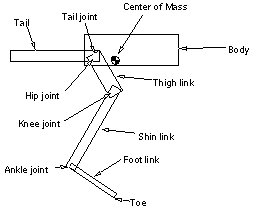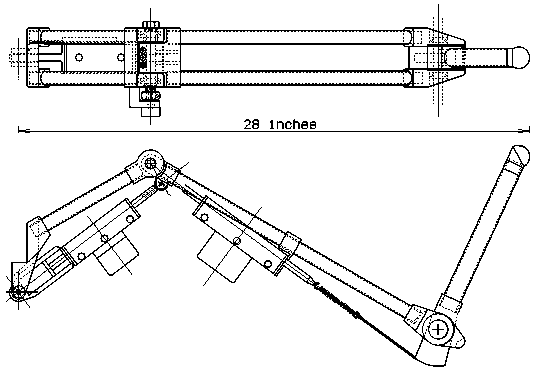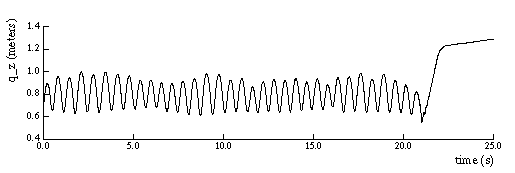
Carnegie Mellon University > Robotics Institute > Garth Zeglin > Research > Uniroo
In 1990-1991 as an undergraduate at MIT I worked with Marc Raibert and David Barrett at the MIT Leg Lab to develop a one legged kangaroo robot. It was the first machine in the lab to have revolute joints for the hip, knee, and ankle. It also featured a tail. Like the other machines of its era, it was hydraulically powered by an off-board pump.
I wrote my B.S. thesis about the project. The reference is as follows: Garth Zeglin. Uniroo: A One Legged Dynamic Hopping Robot. B.S. thesis, MIT Dept. of Mechanical Engineering, 1991. [1835K PDF file]
The MIT Leg Lab also has information on the MIT Leg Lab Uniroo page.
Legged animals exist in a variety of configurations, which produce a variety of modes of locomotion. We have created a machine that mimics kangaroo locomotion in order to gain insight into the nature of hopping.
The robot is kinematically similar to a kangaroo, but has one leg and is constrained to two dimensions. The machine has performed numerous runs of approximately ten hops, and two runs of approximately forty hops. The experimental results indicate that a virtual leg concept can be applied to control a three-link leg with revolute joints.
This paper includes discussion of the experimental results, an introduction to virtual leg ideas, and descriptions of the mechanical, electronic, and software details of the robot.

Photo 1 is a portrait of the robot. All photographs were taken with the machine unpowered, hanging on its wrangling rope. The front of the Uniroo is on the left side of the picture. The leg of the machine is partially obscured behind the boom.

Photo 2 shows the Uniroo as viewed from the inside of its track. Notice the boom pivot in the lower right hand corner, with the umbilical snaking around it and up the boom.The tail is the slender tube on the right side of the body, angled down at about 30 degrees. The tube that extends beyond the front and rear of the machine is used to adjust the balance of the machine, and a mass can be seen on the front end of it.

Side view illustration, showing the placement of the hydraulic actuators. Note also the large spring in the rear of the ankle that functioned like an elastic Achilles tendon.

Schematic diagram. Note how the center of mass is located above the foot, and the knee is placed along the foot-COM axis.

Mechanical drawing of leg. Most of the mechanical design was performed by David Barrett.

Plot of the vertical position while hopping.
Page revision: 2006/03/24 20:14:40.
Garth Zeglin, Robotics Institute, Carnegie Mellon University.